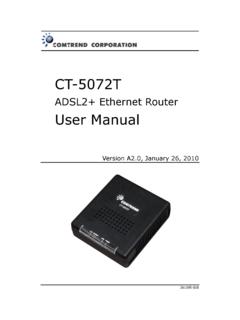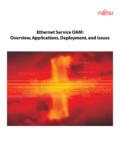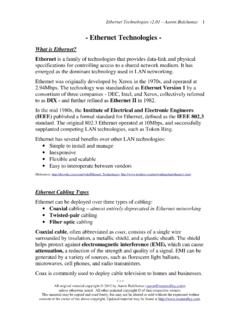Transcription of The IEEE 802.3 Standard (Ethernet): An Overview of …
1 The IEEE Standard ( ethernet ): An Overview of the Technology Rion Hollenbeck ICS 620 Dr. Jones 17 September, 2001 1 Table of Contents Introduction .. 2 Evolution of the IEEE Standard .. 2 IEEE Subtypes .. 3 How ethernet Works: In Brief .. 4 Relation to the OSI Model .. 6 Carrier Sensing Multiple Access with Collision Detection (CSMA/CD) .. 7 Data Transmission .. 8 Frame Collisions.
2 9 The IEEE Data Frame .. 11 Cyclic Redundancy Check .. 14 Manchester Encoding .. 15 IEEE Physical Media .. 16 Benefits and Limitations of IEEE .. 18 Conclusions .. 20 References 2As the 21st century begins, data communications and networking will continue to grow in importance and necessity.
3 With this necessity comes the need for fast and reliable transfer of data from one place to another. Many network protocols have been developed and are in use, but the most widely used in Local Area Networks is the ethernet Standard . The following discussion will present an Overview of the ethernet (IEEE ) Standard . The paper will cover a brief history of the development of the ethernet Standard and how that has evolved to the IEEE Standard . The evolution from original ethernet to 1Gb/s ethernet will be presented with a focus on the 10 Mb/s Standard . How the ethernet Standard fits into the OSI network model will be discussed briefly followed by a detailed look at how the Carrier Sensing Multiple Access with Collision Detection (CSMA/CD) Standard works.
4 The basis of the ethernet system, the data frame, will be analyzed and presented. In addition, a brief discussion on the hardware and physical topology of an ethernet network will be presented. Finally a brief discussion will be presented on the benefits and limitations of the ethernet system. The scope of this paper is an elementary look at the ethernet Standard for network protocol. The discussion will focus on an analysis of the 10 Mb/s Standard . The term ethernet will be used interchangeably with IEEE understanding that the original ethernet protocol differs very slightly from the IEEE Standard .
5 Evolution of the IEEE Standard Back in the 1970s at the Xerox Palo Alto Research Center, Dr. Robert M. Metcalf developed a network Standard that enabled the sharing of printers to personal workstations (Slone, 1998)(Fairhurst, 2001d)(Gilbert, 1995). This original system, entitled the Alto Aloha Network (later re-named ethernet ), was able to transmit data at a rate of 3 Mb/s between all 3connected computers and printers (Kaplan & Noseworthy, 2000). Later, in 1980 a multi-vendor consortium consisting of DEC, Intel, and Xerox released the DIX Standard for ethernet .
6 It was through this effort that ethernet was able to become an open Standard for network operations (Fairhurst, 2000d). At the same time, the Institute of Electrical and Electronic Engineers (IEEE) created a group designated the 802 Working group to standardize network technologies. This group created standards that they would later number , where x was the subcommittee developing the particular Standard (Pidgeon, 2001b). The subcommittee that developed the standards for the CSMA/CD, functionally very similar to the DIX ethernet system, was Later in 1985, the official standards were released for the IEEE The standards were for Carrier Sensing Multiple Access with Collision Detection access method (Pidgeon, 2001b).
7 It is important at this point to distinguish between original DIX ethernet and what is termed ethernet today. ethernet today refers to the IEEE standards . Although functionally similar, there are subtle differences between the two standards . The main differences lay with the frame structure, which will be discussed later, and the data transfer rates. For now, when the term ethernet is used, it refers to the IEEE standards . IEEE Subtypes There are currently three versions of ethernet available for commercial use. The difference between these types lies in the speed at which they can transmit data.
8 The earliest form of the IEEE Standard , still in use today by many offices and LANs, is the 10 Mb/s speed. This means that this version can transmit data at 10 Mb/s (1,000,000 bits / second). The 410 Mb/s ethernet can transmit over thick or thin Coaxial cable, UTP (Unshielded Twisted Pair) wire, or fiber optic cable. The early Thick and Thin ethernet , which referred to the type of coaxial cable used, were set up in a bus topology. This means that the machines were all connected directly to the main transmission medium in a linear fashion. However, with UTP as the transmission medium of choice, the topology of ethernet networks have evolved into the Star topology.
9 In the star topology, all machines are connected to a central hub, router, or switch. This greatly reduces the problems associated with damaged cabling (Cisco Systems, 1999). The next category is the 100 Mb/s ethernet or Fast ethernet . The only functional difference between these two is the speed of data transmission. With a transfer rate of 100 Mb/s, this system typically uses either Category 5 UTP cable or Fiber Optics for the transmission medium (Cisco Systems, 1999). The newest form of ethernet is the 1 Gb/s category. This technology is functionally similar to the 10 and 100 Mb/s technologies, but has subtle differences.
10 The main difference is that the transmission medium for 1 Gb/s ethernet is the fiber optic cable not UTP (Cisco Systems, 1999). The remainder of the discussion focuses on the technology of the 10 Mb/s ethernet Standard . These standards also apply to the 100 Mb/s ethernet Standard . How ethernet Works: In Brief The ethernet system works off of the CSMA/CD Standard . CSMA/CD simply means that the computers all have access to the transmission medium, and can send and receive data whenever the network is idle. The benefit of ethernet is that it has the ability to sense collisions on the network (Pidgeon, 2001a).







